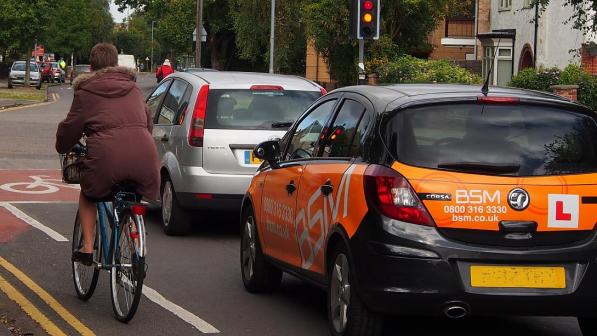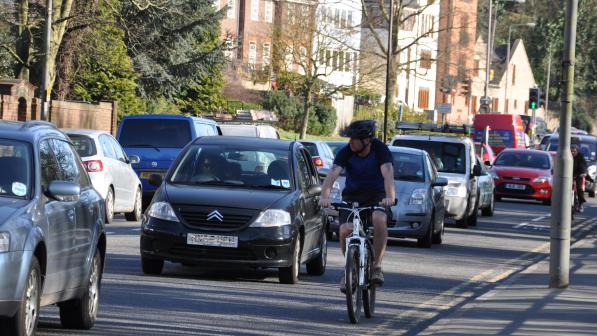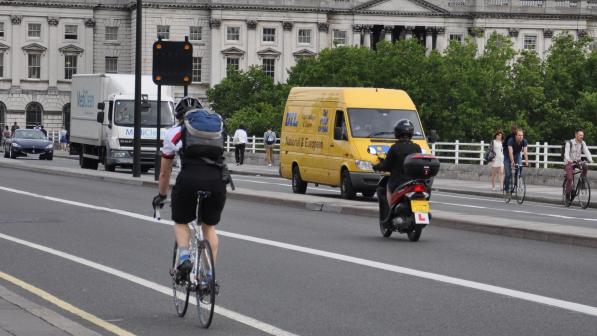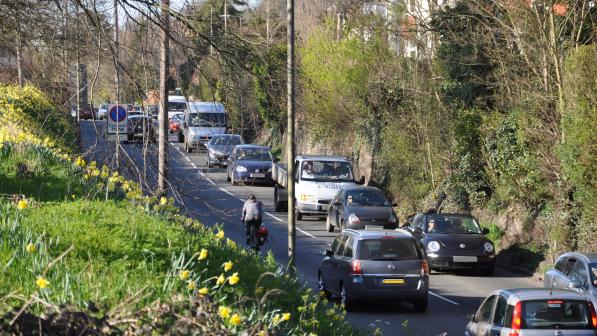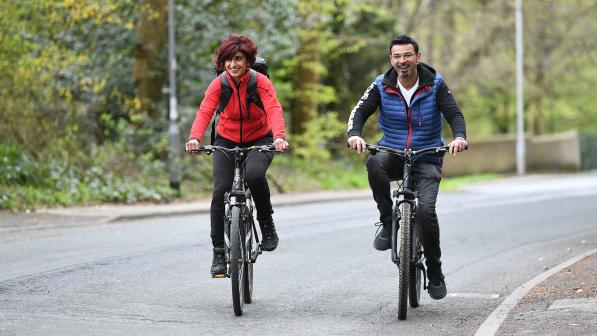What should the Highway Code say about overtaking distances?

Update: 28 July 2020
Since this article first appeared, Cycling UK has been closely involved with the Department for Transport's (DfT) pre-consultation on a review of the Highway Code.
The DfT has now announced an official, open consultation and we're pleased to say that many of the changes we've suggested are among the proposals. One of them is to introduce new rules to tackle dangerous overtaking and ‘close passes’, with a guideline minimum safe passing distance of 1.5m.
But, to make these proposals a reality, it's vital that road users of all kinds write to the DfT to show their support. Otherwise, they could be dropped. Please help us make it happen! (Deadline 27 October 2020).
Support changes to make the Highway Code safer
Thank you.
Please read on for our original article.
Background
There are 307 rules in the Highway Code (HC). Those saying ‘MUST’ or ‘MUST NOT’ relate to statute law, and breaching them is an offence. Infringing the other rules is not inherently criminal, but may be used in court to decide whether a more general offence has been committed (e.g. ‘careless’ or ‘dangerous’ driving, or obstruction of the highway), or whether civil liabilities have occurred (whether someone is owed compensation for injury or property damages).
Typically, the HC is fully reviewed every six or seven years, but there has been no review since 2007, when Cycling UK’s campaigning led to 40 changes to the initial consultation draft.
Although some changes to the Code have been made piecemeal, another comprehensive revision is long overdue, not least because of the need to ensure that the rules take account of the increasing automation of vehicles, and of various changes which have been made to traffic signs and signals (many of which have provided welcome benefits for cycling).
While Cycling UK argues that a full review is needed, there are four specific recommendations for rule changes which are particularly important either for cycle safety, or to prevent people from being deterred from cycling. These cover overtaking distances (which we discuss here), along with ‘car dooring’, rules on junction priority and removing prejudicial rules on helmets and hi-viz (we discuss these in other articles).
Note: the Highway Code (HC) applies in England, Scotland and Wales (GB). There is a separate HC in Northern Ireland (NI), which is based on the GB version.
The specific rules referred to in this article are the same in both the GB and NI versions. Cycling UK’s recommendations on HC amendments are therefore relevant throughout the UK, but would need to be implemented separately in NI.
The current rules on overtaking distances
HC rules 162-169 deal with overtaking generally, with Rule 163 referring to the distance to leave when overtaking a cyclist, and advising drivers to overtake only when it is safe and legal to do so and “give motorcyclists, cyclists and horse riders at least as much room as you would when overtaking a car”.
It is not clear, however, how much room that is, because the space people give when overtaking cars varies considerably. If a driver routinely overtakes other motor vehicles leaving less than a one metre gap, does Rule 163 imply that this is all they have to leave when overtaking a cyclist, regardless of their speed, the weather and the road conditions?
Rule 212 also refers to overtaking cyclists and motorcyclists, with advice to “give them plenty of room”. This phrase is repeated in Rule 213 in the context of advice that they “may suddenly need to avoid uneven road surfaces and obstacles such as drain covers or oily, wet or icy patches on the road”.
But ‘plenty of room’ is another subjective concept.
Cycling UK’s recommendations
We recommend that either Rule 163 is amended, or a new rule inserted, to specifically refer to a minimum passing distance guideline. Before expanding on this proposal, and explaining why a guideline in the HC is preferable to a minimum passing distance set by statute, it is important to explain why being overtaken too close is a major barrier to getting more people cycling, especially less confident cyclists, women, older people and children.
The Near Miss Project
The ‘Near Miss Project’ investigated the rates and impacts of near misses and related incidents among UK cyclists. Participants were asked to keep a record of all cycle trips and any incidents on a nominated day, which enabled a per-mile rate for UK cycling 'near misses' to be calculated for the first time. The research provided insight into incident rates, as well as types of near misses, how they affect people, and how cyclists think they might be prevented.
One headline finding was that near misses, including those reported as "scary", are a normal experience for many people cycling in the UK. Overall rates did not differ much depending on where people live, although the types of incident did.
The study did, however, find a gender difference in rates. Women reported more incidents per mile than men, although that was due to a difference in speed, with people who reached their destinations faster reporting fewer incidents. So, slower cyclists experience more near misses. This is of particular concern given that increasing and diversifying cycling requires the creation of comfortable cycling conditions for a range of ages and abilities.
Other headline findings of the project included:
- Fear of injury is a barrier to cycling, and experiencing non-injury incidents (near misses) may contribute to this;
- UK cyclists experience very high rates of non-injury incidents, in comparison with any reported injury rates;
- The most frightening incidents involve moving motor vehicles, particularly larger vehicles;
- Problematic passing manoeuvres are especially frequent and frightening;
- Higher rates are experienced in the morning peak and by slower cyclists.
The very high rates of non-injury incidents by comparison to reported injury cases is crucially important. This is because road safety policy is often driven by casualty statistics, and close passes / near misses do not register on those statistics.
What the Near Miss Project demonstrates, though, is that experiencing those near misses can create a fear of injury, which is a barrier to cycling. Consequently, changing the HC to include a guideline minimum distance to leave when overtaking a cyclist not only has road safety benefits, but would also help encourage more cycling by less experienced cyclists.
Minimum distance guideline
Other countries
Various countries and states have passed minimum passing distance laws (MDL) to make it an offence to overtake a cyclist leaving less than the stated minimum distance. Those distances have varied: some, for instance, opt for 1 metre at speeds below 50 km/h (31 mph) and 1.5 metres at speeds above 50 km/h, while others opt for 1.5 metres whatever the speed.
Comparisons between countries, however, are not particularly helpful given the difference in road conditions, traffic volumes, cultural attitudes towards cycling, traffic law and levels of enforcement. In addition, as the Near Miss Project shows, there are wider benefits in reducing close passing incidents that are not obvious from casualty statistics alone.
Why Cycling UK does not recommend a Minimum Distance Law in the UK
Cycling UK is not recommending an MDL. This is because it would be difficult to enforce given the need to establish in evidence the exact distance and speed of the overtaking vehicle, if the minimum distance set by the law were linked to driving speed.
By way of example: if the minimum distance set were 1.5 metres at under 30 mph, and 2.0 metres above that speed, then the police might have to prove that a driver was travelling at 31 mph rather than 29 mph. Equally, the driver might dispute the alleged distance – they might claim it was 1.45 metres, and the police that it was 1.55.
Why Cycling UK prefers guidelines in the Highway Code
Cycling UK would prefer to see minimum distances set as guidelines within the HC. This would not only provide much clearer advice than the current rules, but also allow for a degree of nuance and flexibility to take account of road conditions, weather, speed of both cyclist and the overtaking vehicle, and its size and type, etc.
What should the guidelines say?
HC guidelines could advise:
- A guideline minimum distance of 1.5 metres at speeds under 30 mph;
- A guideline minimum distance of 2.0 metres at speeds over 30 mph;
- All drivers to take extra care and consider giving more space when overtaking cyclists in bad weather.
- Drivers of larger vehicles (buses, lorries etc.) to take extra care and consider leaving more space when overtaking cyclists.
To ensure that any changes to the HC had maximum effect on driver behaviour, they would have to be linked with and promoted by a robust and well-resourced public awareness campaign.
- The above recommendation was one of over 80 we made in our 'Cycle safety: make it simple' response to the Department for Transport's Cycle Safety Review (June 2018).

